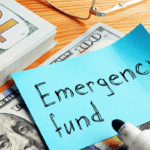
Even if your budget doesn’t have a ton of wiggle room, it’s still possible to save for a rainy day, but it requires consistency and patience.
Here are four things to consider when building an emergency fund:
- An emergency fund is a long-term goal
Some people talk about building an emergency fund as if it’s just one more thing on your to-do list — like going to the doctor or doing the grocery shopping. If only it were that easy. The truth is, building a three to six-month emergency fund can take years if most of your paycheck is consumed by bills. For example, if your necessities eat up 90% of your post-tax income and you put the remaining 10% in emergency savings, you’d need about 27 months to build a three-month emergency fund.
But even if you are only able to set aside $20 or $30 a month, that’s still progress. You may not have a full three months or six months of savings, but any amount of cash you have in a savings account provides a safeguard from the unexpected.
- Your savings needs will change
As life changes, so will your emergency savings need. Some lifestyle inflation — which is when you increase your spending as your income rises — is natural. So, if you upgrade to a more expensive apartment or car when your paycheck gets bigger, your emergency fund needs to increase to reflect those costs.
Also, while a three-month emergency fund may suffice when you’re young, healthy, and single, you may want to aim for a six-month emergency fund as you get older, particularly once you have children.
- Pay off debt vs. save?
If you’re wondering whether to pay off debt versus build your emergency fund, there’s no one-size-fits-all rule. Clearly, an emergency fund takes precedence over paying off low-interest debt, like a mortgage. But what about those high-interest credit cards? Here’s the approach that was used tby some people:
- Build a one-month emergency fund first.
- Then put all my excess funds each month toward credit cards.
- After paying off my credit cards, focused on a three-month emergency fund.
- Once you build a three-month emergency fund, the start splitting the excess funds between the emergency fund and Roth IRA.
- Irregular expenses aren’t necessarily emergencies
Things some people have used their emergency fund for in the past:
- Replacing the tires and brakes on my car.
- Their dog’s dental cleaning.
- Holiday gifts.
None of these were emergencies, of course, nor were they unexpected expenses. But they were irregular expenses — something that a lot of people fail to plan for.
When you’re building an emergency fund, try going back through your spending for the past six to 12 months, keeping an eye out for those irregular expenses. Working them into your budget is essential. That may mean you have to go a bit slower as you build your rainy-day fund.
But that’s OK, because at least you’re being honest with yourself. If you’re telling yourself that you have a three-month emergency fund, but you know you’ll raid it for routine car maintenance or dental work, you don’t really have a three-month emergency fund.
How to speed up your savings
No matter how disciplined you are, you’ll probably feel like you’re not saving fast enough. Try not to get discouraged. But if you want to speed up your progress, consider these strategies.
- Try a no-spend challenge. A no-spend challenge is when you commit to not spending money on any non-necessities for a certain period, be it a week or a month. Alternatively, you could choose a day or two each week to take on the challenge, then pocket the extra savings.
- Commit to saving your next raise. If you don’t have much fat to cut from your budget, make a commitment to allocate as much of your next raise as you can toward savings. For example, you may need 50% of your next raise to cover increased living costs but set up automatic transfers for the remaining 50% to your savings account.
- Consider a short-term side hustle. Your paycheck will only stretch so far. If you can’t afford to squeeze much savings out of it, consider a part-time job or a side gig. You don’t have to make a long-term commitment to hustle culture. Working a seasonal part-time job for three months or doing a side gig a weekend or two each month, like ride-share driving or grocery delivery, can help you make huge progress toward your goals relatively quickly.
